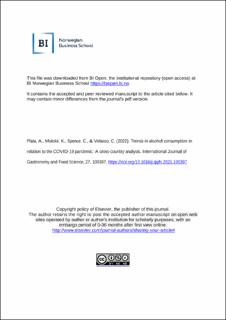| dc.description.abstract | During the first sequence of lockdowns implemented in many countries around the world in early 2020 as a result of the emerging COVID-19 pandemic, there was widespread concern amongst many health professionals regarding a predicted rise in alcohol consumption. However, studies have reported diverse findings, with some consumer groups exhibiting an increase and others a decrease in their alcohol purchase and consumption patterns. Although the long-lasting changes in alcohol consumption, if any, are still unknown, the current situation has effectively accelerated a number of pre-existing trends which will likely continue in the future. E-commerce is growing steadily, mainly because of the restrictions within the on-trade channel and concerns around catching COVID-19 amongst consumers, thus lifting traditional barriers to the adoption of digital channels. Premiumization has also grown significantly during the pandemic, especially in the spirits category, due, in part, to the fact that consumers have been increasingly trying to recreate bar and restaurant quality gastronomic experiences in the privacy of their own homes. The trend toward homemade experiences is multi-stakeholder as consumers, retailers, restaurateurs, bar owners, and brands all try to help facilitate at-home consumption experiences. Larger size purchases seem to reflect not only the stockpiling phenomena that occurred during the initial phases of the pandemic but also convenience for consumers (e.g., avoiding queues). Additionally, the growing home mixology movement has been observed to result in consumers buying larger amounts of alcohol in order to facilitate cocktail making experimentation at home. It is important to stress, though, that this review was specially focused on available data from the first three quarters of 2020, as an effort to identify and understand the initial impacts the COVID-19 was creating amongst alcohol consumers. It currently remains uncertain how these trends will evolve, and whether or not they will continue post COVID-19 (whenever that might be). Key similarities and differences across national markets are highlighted. | en_US |

